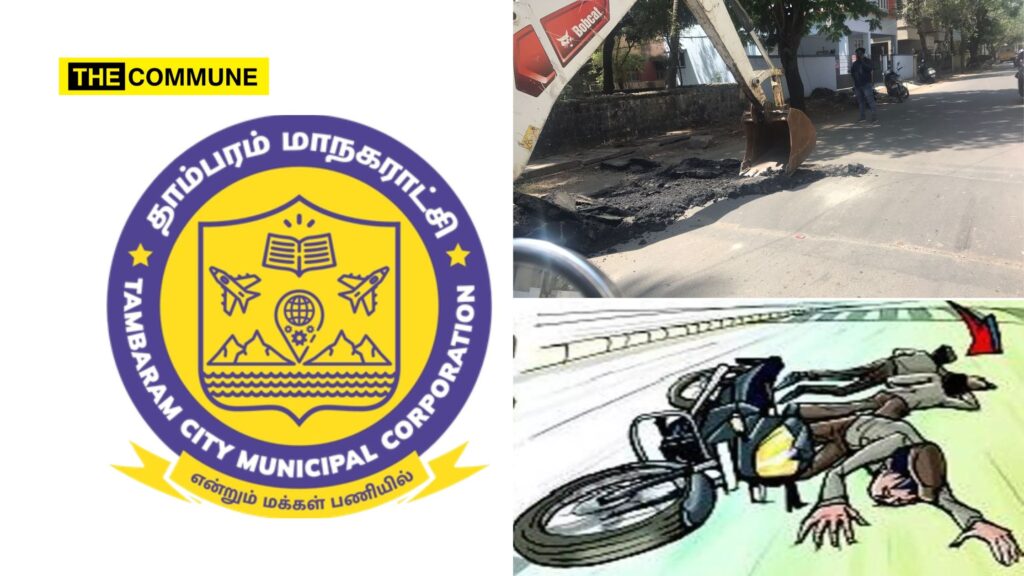Chaos ensued in Tambaram corporation on 29 February 2024 as AIADMK opposition councillors walked out, citing the perilous state of roads and drains within municipal limits, which they argued had transformed into virtual death traps. They highlighted the danger posed by unscientifically constructed speed-breakers, citing two recent fatalities and three severe injuries in the past five days alone.
The councillors accused Tambaram corporation of poor speed-breaker construction, attributing two deaths to these inadequately designed road features. They also criticized the civic body’s budget allocation for roads and drains, pointing to recent fatalities and demanding improved safety measures.
The incidents included a 34-year-old man’s death due to a poorly planned speed-breaker and a construction worker named Valli (48) losing her life in a similar incident. Valli, while riding pillion on a bike, suffered head injuries when the vehicle lost control near Anakaputhur after crossing a speed-breaker.
Cinema-style murders in #chennai city and deaths caused by bad roads… pic.twitter.com/8Bl7sxRK0s
— Sidharth.M.P (@sdhrthmp) March 1, 2024
Councillor Star Prabha cited another incident in Chitlapakkam, where 36-year-old man named Govindarajan died after hitting a poorly marked and slightly oversized speed-breaker. He struck a lamp post, sustaining fatal injuries. The police registered a case under relevant sections of the IPC and highlighted the absence of signboards for the speed-breaker, contrary to Indian Roads Congress guidelines.
A man dies due to unmarked big speed breaker in Chitlapakkam.
Sad,our govt needs an accident before reactions.
Many potholes remain in Chitlapakkam. Many have been hurt and killled. Illegal banners, flag poles, open drains. The list risks expands.@Chief_Secy_TN @CMOTamilnadu pic.twitter.com/akVVwigppl— Chitlapakkam Rising (@Chitla_Rising) February 28, 2024
In response, a civic official argued that the corporation was addressing the issue and blamed welfare associations for laying some speed-breakers, compromising public safety.
PMK advocate K Balu asserted to DTNext news that safe roads are a fundamental citizen right, encouraging aggrieved parties to present their concerns to the relevant authorities. If the authorities fail to act, residents can seek legal recourse through the High Court.
Residents, like Naveen from Tambaram, emphasized that poorly designed speed-breakers, raised above normal levels and lacking reflectors, are contributing to accidents.
Indian Roads Congress Guidelines
As per the Indian Roads Congress guidelines outlined in IRC 99-2018, the effectiveness of speed humps in terms of speed reduction depends on factors such as profile, height, gradient, length, and the design material. Notably, speed breakers are discouraged on bus routes due to the discomfort they cause to passengers.
In urban areas, Collector Roads should incorporate a speed breaker 50 meters before intersections with arterial or sub-arterial roads. Additionally, warning signs indicating ‘speed breakers ahead’ are recommended. For local roads, the provision of speed breakers is suggested at intervals of every 200 meters.
The IRC proposes several alternatives for speed reduction, including modifying surface texture to induce discomfort, as accidents associated with speed breakers and humps with vertical shifts are less common compared to those involving uneven road surfaces or stone-set pavements. Another effective measure endorsed by the IRC is the installation of a central island in an undivided carriageway in urban streets. This not only reduces speed but also serves as a refuge space for pedestrians.
It is worth mentioning that the guidelines from the Indian Roads Congress suggest a rounded speed-breaker with a 17-meter radius, 3.7-meter width, and a height of 0.10 meters.
Here's a look at the guidelines under the Indian Roads Congress:
According to Indian Roads Congress IRC 99-2018 (https://t.co/7Eu3Z5dPno)
The degree of the effect of the humps in terms of speed reduction depends upon the profile, height, gradient, length… pic.twitter.com/39B23tgHng— R Aishwaryaa (@AishRavi64) February 28, 2024
(With inputs from DTNext)
Subscribe to our channels on Telegram and WhatsApp and get the best stories of the day delivered to you personally.

